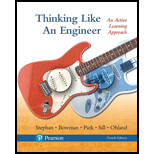
Concept explainers
The space shuttle fleet was designed with two booster stages.
- a. If the first stage provides a thrust of 5.25 mega-newtons [MN] and the space shuttle has a mass of 4,470,000 pound-mass [lbm], what is the acceleration of the spacecraft in miles per hour squared [mi/h2]?
- b. If the second stage provides a thrust of 75 kilo-newtons [kN] and the space shuttle has an acceleration of 15,000 miles per hour squared [mi/h2], what is the mass of the spacecraft in units of pounds-mass [lbm]?
a.
Calculate the acceleration of the spacecraft in miles per hour squared.
Answer to Problem 1ICA
The acceleration of the spacecraft in miles per hour squared is
Explanation of Solution
Given data:
The thrust provided in the first stage is 5.25 MN, and
Mass of the space shuttle is
Formula used:
Write the expression for force.
Here,
Calculation:
Consider the conversion factor to convert MN to N.
Consider the above conversion factor to convert 5.25 MN to N.
Consider the conversion factor to convert
Consider the above conversion factor to convert
Rearrange equation (1) to solve for the acceleration ‘a’.
Substitute
Consider the conversion factor to convert
Consider the above conversion factor and convert the value
Conclusion:
Hence, the acceleration of the spacecraft in term of miles per hour squared is
b.
Calculate the mass of the spacecraft in units of pounds mass.
Answer to Problem 1ICA
The mass of the spacecraft in pounds is
Explanation of Solution
Given data:
The thrust provided in the second stage is 75 kN, and
Acceleration of the space shuttle is
Calculation:
Consider the conversion factor to convert kN to N.
Consider the above conversion factor to convert 75 kN to N.
Consider the conversion factor to convert
Consider the above conversion factor to convert
Rearrange equation (1) to solve for m.
Substitute
Consider the conversion factor to convert kg to
Consider the above conversion factor and convert the value 40,267.37 kg to
Conclusion:
Hence, the mass of the spacecraft in the units of pounds is
Want to see more full solutions like this?
Chapter 8 Solutions
Thinking Like an Engineer: An Active Learning Approach (4th Edition)
Additional Engineering Textbook Solutions
Web Development and Design Foundations with HTML5 (8th Edition)
Concepts Of Programming Languages
Starting Out with Java: From Control Structures through Objects (7th Edition) (What's New in Computer Science)
Introduction To Programming Using Visual Basic (11th Edition)
Java: An Introduction to Problem Solving and Programming (8th Edition)
Electric Circuits. (11th Edition)
- a ship 150 m long and 20.5 m beam floats at a draught of8 m and displaces 19 500 tonne. The TPC is 26.5 and midshipsection area coefficient 0.94. Calculate the block, prismatic andwaterplane area coefficients.arrow_forwardA vessel loads 680 t fuel between forward and aft deep tanks. centre of gravity of forward tank is 24m forward of ships COG. centre to centre between tanks is 42 m. how much in each tank to keep trim the samearrow_forwardBeam of a vessel is 11% its length. Cw =0.72. When floating in SW of relative denisity 1.03, TPC is 0.35t greater than in freshwater. Find the length of the shiparrow_forward
- An inclining experiment was carried out on a ship of 4000tonne displacement, when masses of 6 tonne were moved transverselythrough 13.5 m. The deflections of a 7.5 m pendulurnwere 81, 78, 85, 83, 79, 82, 84 and 80 mm respectively.Caiculate the metacentric height.arrow_forwardA ship of 10 000 tonne displacement has a waterplanearea of 1300 m2. The ship loads in water of 1.010 t/m3 andmoves into water of 1.026 t/m3. Find the change in meandraughtarrow_forwardA ship of 7000 tonne displacement has a waterplane areaof 1500 m2. In passing from sea water into river water of1005 kg/m3 there is an increase in draught of 10 cm. Find the Idensity of the sea water.arrow_forward
- A ship has 300 tonne of cargo in the hold, 24 m forward ofmidships. The displacement of the vessel is 6000 tonne and its centre of gravity is 1.2 m forward of midships.Find the new position of the centre of gravity if this cargo ismoved to an after hold, 40 m from midshipsarrow_forwardSketch and describe how ships are supported in dry dock. When and where does the greatest amount of stresses occur?arrow_forwardSketch and desribe a balanced rudder and how it is suspendedarrow_forward
- A ship 140 m long and 18 m beam floats at a draught of9 m. The immersed cross-sectionai areas at equai intervais are 5,60, 116, 145, 152, 153, 153, 151, 142, 85 and 0 m2 respectively.Calculate:(a) displacement(b) block coefficient(c) midship section area coefficient(d) prismatic coefficient.arrow_forwardA steamer has waterplane area 1680m2 recorded in water with relative denisty 1.013. Displacement = 1200 t, calculate difference in draught in salwater reltive denisity 1.025.arrow_forwardrelative velocity 11.72 m/s is correct, need help finding the angle pleasearrow_forward
 Elements Of ElectromagneticsMechanical EngineeringISBN:9780190698614Author:Sadiku, Matthew N. O.Publisher:Oxford University Press
Elements Of ElectromagneticsMechanical EngineeringISBN:9780190698614Author:Sadiku, Matthew N. O.Publisher:Oxford University Press Mechanics of Materials (10th Edition)Mechanical EngineeringISBN:9780134319650Author:Russell C. HibbelerPublisher:PEARSON
Mechanics of Materials (10th Edition)Mechanical EngineeringISBN:9780134319650Author:Russell C. HibbelerPublisher:PEARSON Thermodynamics: An Engineering ApproachMechanical EngineeringISBN:9781259822674Author:Yunus A. Cengel Dr., Michael A. BolesPublisher:McGraw-Hill Education
Thermodynamics: An Engineering ApproachMechanical EngineeringISBN:9781259822674Author:Yunus A. Cengel Dr., Michael A. BolesPublisher:McGraw-Hill Education Control Systems EngineeringMechanical EngineeringISBN:9781118170519Author:Norman S. NisePublisher:WILEY
Control Systems EngineeringMechanical EngineeringISBN:9781118170519Author:Norman S. NisePublisher:WILEY Mechanics of Materials (MindTap Course List)Mechanical EngineeringISBN:9781337093347Author:Barry J. Goodno, James M. GerePublisher:Cengage Learning
Mechanics of Materials (MindTap Course List)Mechanical EngineeringISBN:9781337093347Author:Barry J. Goodno, James M. GerePublisher:Cengage Learning Engineering Mechanics: StaticsMechanical EngineeringISBN:9781118807330Author:James L. Meriam, L. G. Kraige, J. N. BoltonPublisher:WILEY
Engineering Mechanics: StaticsMechanical EngineeringISBN:9781118807330Author:James L. Meriam, L. G. Kraige, J. N. BoltonPublisher:WILEY





